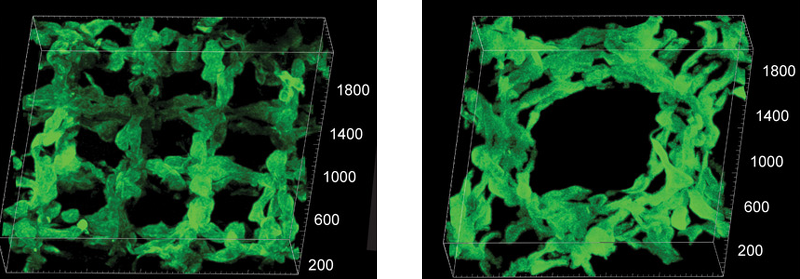If you are like us, you tend to do your 3D printing with plastic or maybe–if you are lucky enough to have access to an expensive printer–metal. [Adam Feinberg] and his team at Carnegie Mellon print with flesh. Well, sort of. Printing biomaterials is a burgeoning research area. However, printing material that is like soft tissue has been challenging. In a recent paper, [Feinberg] and company outline a method called FRESH. FRESH uses a modified MakerBot or Printrbot Jr. printer to deposit hydrogel into a gelatin slurry support bath. The gelatin holds the shape of the object until printing is complete, at which point it can be removed with heat. If you don’t want to wade through the jargon in the actual paper, the journal Science has a good overview (and see their video below).
The gelatin is mixed with calcium chloride and gelled for 12 hours at low temperature. It was then turned into a slurry using an off-the-shelf consumer-grade blender. A centrifuge was used to remove most of the soluble gelatin. Printing inks were made with materials like collagen and fibrin. The FRESH process actually uses liquid ink that gels in the gelatin.
The printer uses an open source syringe extruder found on the NIH 3D print exchange (they never say exactly which one, though and we had trouble matching it from the pictures). In true hacker fashion, the printer prints its own syringe extruder using the stock one from ABS and PLA plastic. Then you simply replace the standard extruder with the newly printed one (reusing the stock stepper motor).
The paper describes printing items including a model of a 5-day-old embryonic chick heart, an artery, and a miniature human brain model. Another team of researchers in Florida have a similar system, as well.
We’ve talked about bioprinting before and even mentioned how to make your own inkjet-based bioprinter. The FRESH method looks like it is in reach of the hacker’s 3D printing workshop. We cringe to think what you will print when you can finally print body parts.

















organovo took the lead almost two years ago. http://www.organovo.com/science-technology/bioprinted-human-tissue/
“_burgeoning_ research area” is the right wording.
grow stem cells for the body, can the damaged tendon/muscle/bone/nervous system, 3d rebuild the damaged parts, print a gel + stem cells + nutrients + growth regulators and you got a biocompatible replacement part within weeks.
I can just see a SciFi author taking this as a plot element. Want wings? No problem, 3D print you a pair next week, we’ll call you in to implant them next week.
Brain still has to learn to use ’em. Same with a tail :D
Print up a brain expansion. Just avoid the Chinese knockoffs since they’re not at their rated capacity.
+1
SORRY read “JERRY WAS A MAN”
“We cringe to think what you will print when you can finally print body parts.” Well the locker room is gonna get pretty wild I can tell you.
My Chinese brain expansion ha sben 10101100010 daisy daisy give me your answer doooooooo
https://www.youtube.com/watch?v=M9Q3xRsZY00&list=PL2F6EFCE844216691
What was that Bruce Willis movie?
Oh yeah, The Fifth Element,
that is what I think of when there is talk of 3D printing body tissue.
https://www.youtube.com/watch?v=rL6SmtQ3JOo
it’s sprite_tm’s 3d printed jelly shots!
Damn, It’s like it came out of the 5th(?) episode of minority report(series 2015) lol
I’m the first author and lead of the study. I’ll be putting all extruder files up on youmagine. I’ll try to help people get set up with the device as well.
I will also include profiles for the printrbot simple metal(and junior) and replicator (of course running sailfish firmware).
Glad to see my stuff got to hackaday. Btw, Adam did none of the work – if you ask him anything about this, he will just redirect your contact to me.
“Btw, Adam did none of the work”
https://www.wordans.co.nz/wvc-1334345743/wordansfiles/images/2012/4/13/137566/137566_340.jpg
Yeah, he didn’t do the experimental stuff. I’m saying that more informally rather than antagonistically. :) He was the mastermind behind the composition of the actual paper. He’s one hell of an advisor.
Hey, Great paper! thanks a lot for extruder files. Is there a way you can explain in a bit more detail how to convert standard extruder on Printerbot to dual syringe pump extruder?
https://www.youmagine.com/designs/replistruder-syringe-pump-extruder
A twist on “make new friends”…